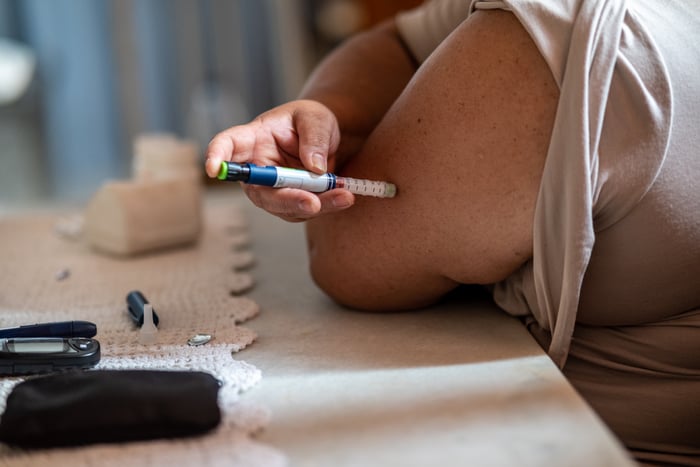J.L. Bainbridge Buys $45 Million in Eli Lilly Stock Despite Price-Pressure Fears
Florida-based wealth advisory J. L. Bainbridge disclosed a purchase of Eli Lilly and Company valued at approximately $45.6 million for the quarter ended September 30, according to an SEC filing released on Friday.
What Happened
J. L. Bainbridge & Co. Inc. significantly increased its stake in Eli Lilly and Company (LLY -1.94%), acquiring 61,258 additional shares during the quarter. The estimated value of the purchase was $45.6 million based on the average closing price for the quarter. The position was reported in the firm’s quarterly Form 13-F filing with the Securities and Exchange Commission on Friday.
What Else to Know
This buy brings the position to 3.9% of J. L. Bainbridge & Co. Inc.’s 13F reportable assets.
Top holdings after the filing:
- NASDAQ:MSFT: $164.85 million (13.9% of AUM)
- NASDAQ:AAPL: $122.68 million (10.4% of AUM)
- NASDAQ:GOOGL: $116.65 million (9.9% of AUM)
- NYSE:GS: $71.43 million (6% of AUM)
- NYSE:ETN: $59.86 million (5.1% of AUM)
As of Friday’s market close, shares of Eli Lilly and Company were priced at $802.83, down 11% over the past year and far underperforming the S&P 500’s nearly 14% gain over the same period.
Company Overview
| Metric | Value |
|---|---|
| Price (as of market close Friday) | $802.83 |
| Market Capitalization | $759.8 billion |
| Revenue (TTM) | $53.3 billion |
| Net Income (TTM) | $13.8 billion |
Company Snapshot
- Eli Lilly offers a broad portfolio of pharmaceuticals for diabetes, oncology, immunology, neuroscience, and other therapeutic areas, with leading products including Humalog, Trulicity, Jardiance, Verzenio, and Taltz.
- The company generates revenue primarily through the discovery, development, manufacturing, and global sale of branded prescription drugs, leveraging both proprietary research and strategic collaborations.
- It provides pharmaceuticals for chronic and complex diseases worldwide.
Eli Lilly and Company is a global pharmaceutical leader that maintains a diversified portfolio of innovative therapies for high-burden diseases. Its scale, established brands, and strategic partnerships provide competitive advantages in the rapidly evolving healthcare sector.
Foolish Take
Florida-based J.L. Bainbridge & Co. boosted its exposure to Eli Lilly last quarter, purchasing roughly $45.6 million worth of shares even as the stock has endured a difficult stretch. Shares are down 11% over the past year, pressured by valuation concerns and, most recently, political commentary on potential weight-loss drug price cuts. The decline followed remarks by President Donald Trump, who suggested GLP-1 treatments like Lilly’s Mounjaro and Zepbound could face price reductions—a move that briefly sent shares tumbling more than 4% on Friday.
Despite near-term volatility, Bainbridge’s purchase reflects long-term conviction in Lilly’s fundamentals. The pharmaceutical giant remains a dominant player in metabolic and diabetes care, with GLP-1 demand still far outpacing supply. Analysts at BMO Capital Markets called the recent selloff “overdone,” noting that most insured Americans already pay modest out-of-pocket costs for these drugs.
For Bainbridge, whose portfolio is anchored by Microsoft, Apple, and Alphabet, the addition of Lilly underscores a strategy centered on durable growth and innovation-led healthcare exposure. Long-term investors may see current weakness as a potential entry point into one of the most profitable franchises in global pharmaceuticals.
Glossary
Form 13-F: A quarterly SEC filing by institutional investment managers disclosing their equity holdings.
AUM (Assets Under Management): The total market value of investments managed on behalf of clients by a fund or firm.
Reportable AUM: Portion of a fund’s assets that must be disclosed in regulatory filings, such as the Form 13-F.
Top holdings: The largest investments in a fund, ranked by their value as a percentage of total assets.
Trailing twelve months (TTM): The 12-month period ending with the most recent quarterly report.
Stake: The ownership interest or position an investor holds in a company, usually measured in shares or percentage.
Strategic collaborations: Partnerships between companies to jointly develop, market, or distribute products or services.
Pharmaceutical portfolio: The collection of drugs and therapies a company develops, manufactures, and sells.
Underperforming: Delivering a lower return or performance compared to a benchmark or peer group.


